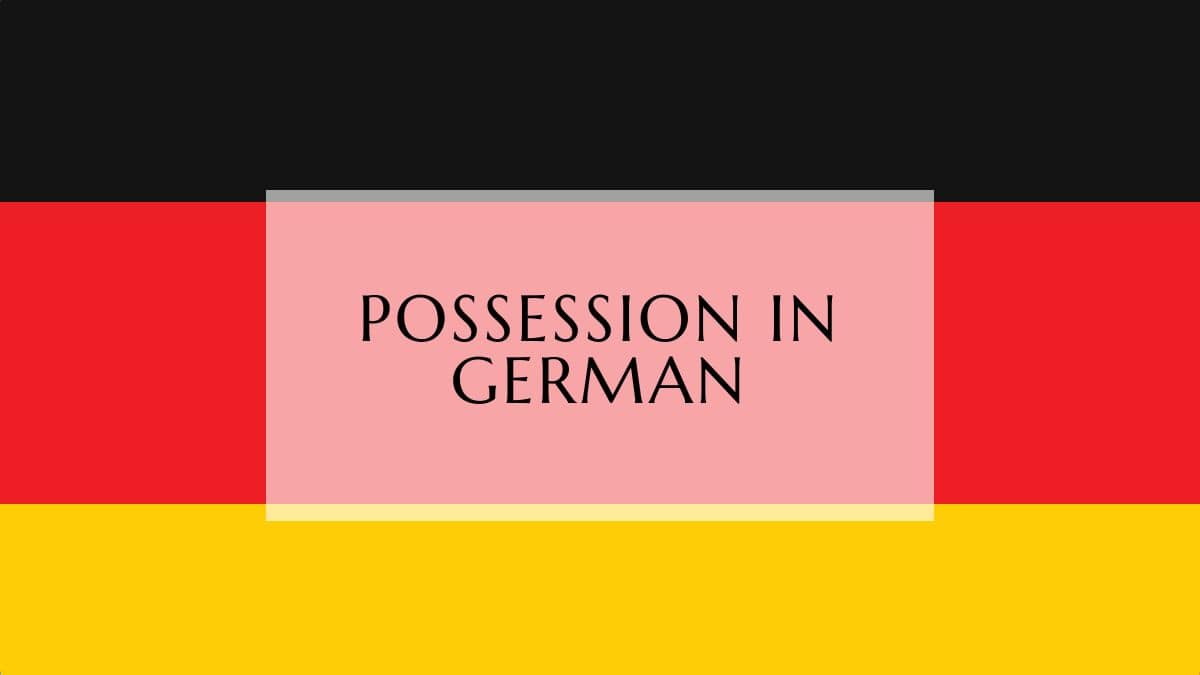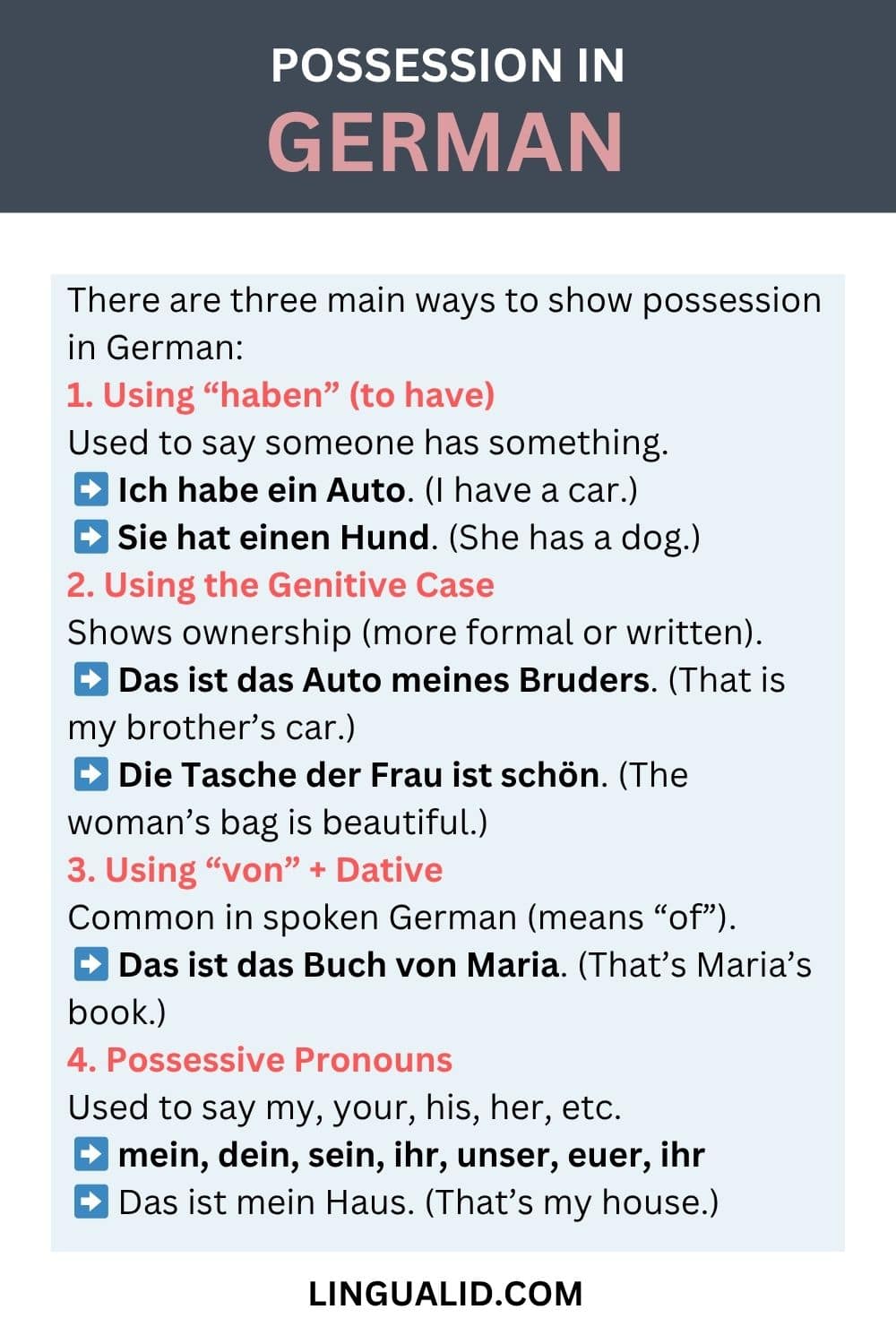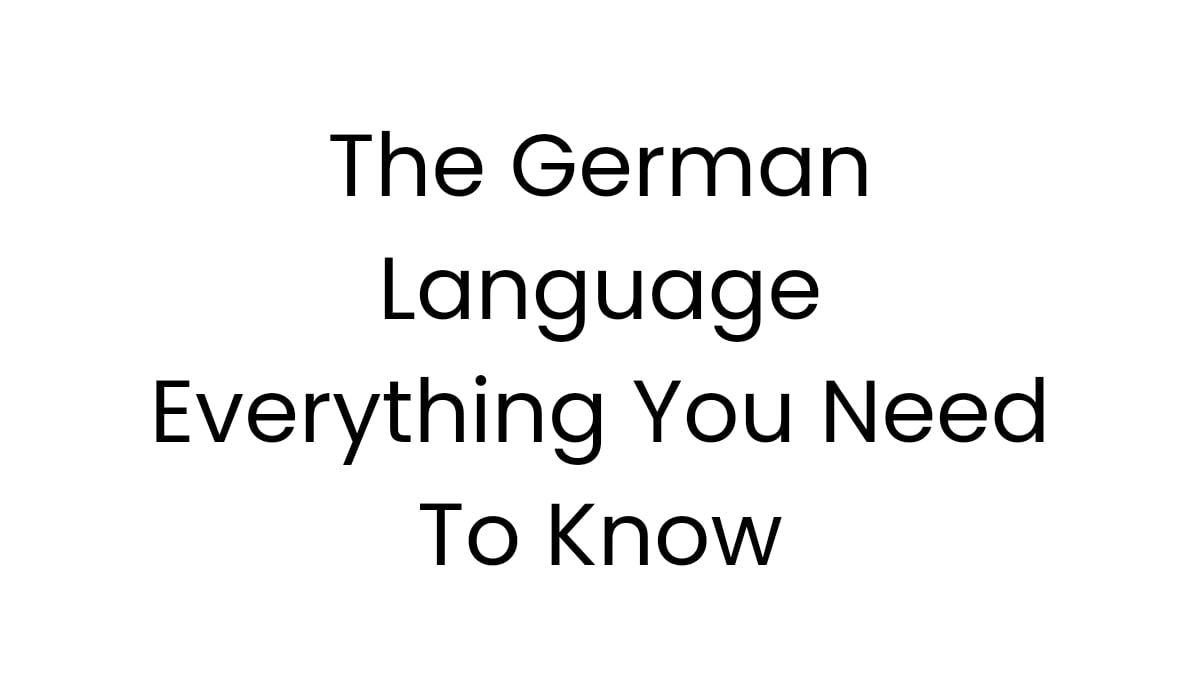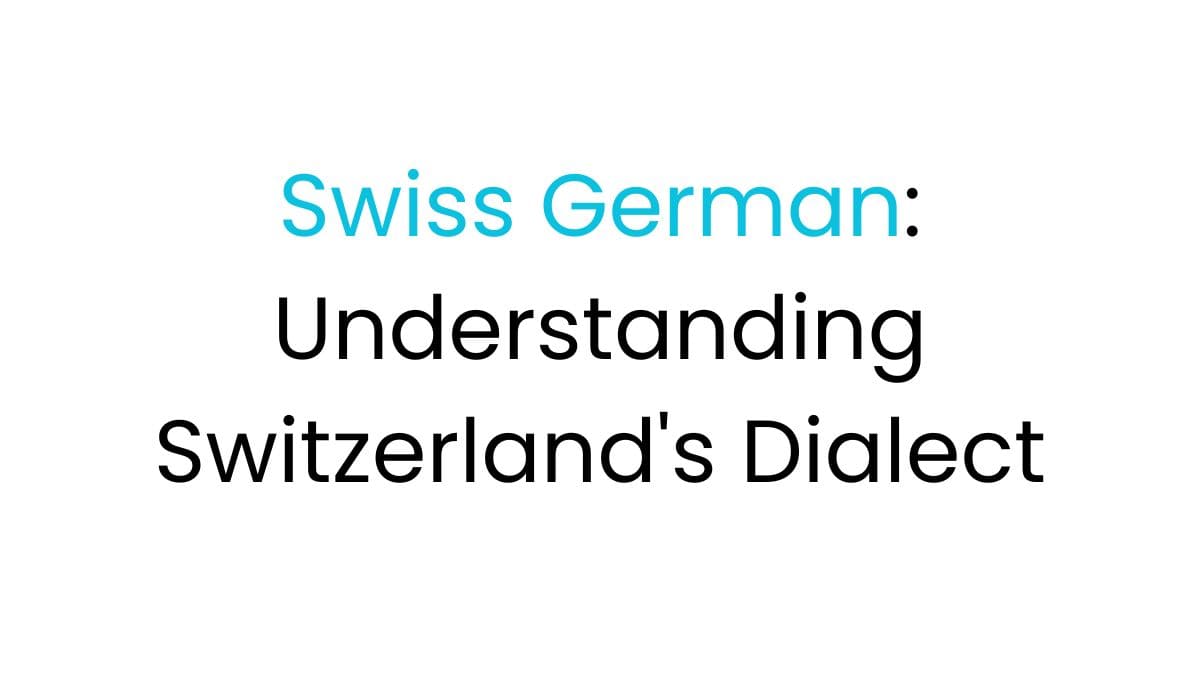Learning about possession in German can make you go from beginner to expert. Knowing how to say “Besitz auf Deutsch” is key. It helps you talk about who owns what clearly and correctly.
Possession in German is more than just saying who owns something. It’s a detailed way of linking words, relationships, and grammar. Whether you’re talking about your favorite book or a friend’s car, these skills will boost your German.
German possessive pronouns are great for making your speech shorter and more natural. Learning these will help you talk like a native and get your point across better.

Key Takeaways
- Master the basics of German possession grammar
- Learn how possessive pronouns simplify communication
- Understand the role of gender in German possession
- Explore different cases and their impact on possessive forms
- Develop skills to express ownership accurately
- Key Takeaways
- Possessive Determiners vs. Pronouns
- The Role of Gender in German Possession
- Basic Possessive Word Forms
- Nominative Case Possessives
- Accusative Case Possessives
- Dative Case Applications
- Definite and Indefinite Articles
- Article Changes in Different Cases
- Common Usage Patterns
- Genitive Case Applications
- Complex Possession Relationships
- Formal vs. Informal Possession
- What's the difference between possessive determiners and possessive pronouns in German?
- How does gender affect possessive words in German?
- What are the four German cases, and how do they relate to possession?
- How do I choose the correct case for a possessive structure?
- What are some common mistakes learners make with German possessive words?
- How do possessive pronouns change in different cases?
- What's the difference between definite and indefinite possessive articles?
- How can I practice using possessive structures in German?
- What role does the genitive case play in expressing possession?
- Are there regional variations in how possession is expressed in German?
Understanding German Possessive Basics
Learning about German Eigentumsverhältnisse means getting the hang of possession in the language. The concept of rechtlicher Besitz is both complex and interesting. It has its own set of rules, unlike English.
German possession uses special pronouns and determiners to show ownership clearly. These tools help tell who owns what with great precision.
Possessive Determiners vs. Pronouns
It’s important to know the difference between possessive determiners and pronouns. Here’s a quick guide:
- Possessive Determiners: Always go with nouns
- Possessive Pronouns: Can stand alone and replace both the noun and adjective
The Role of Gender in German Possession
Gender is key in German Eigentumsverhältnisse. Each possessive word changes based on the noun’s gender:
| Pronoun | Masculine | Feminine | Neuter |
|---|---|---|---|
| Mein (My) | meiner | meine | meines |
| Dein (Your) | deiner | deine | deines |
Basic Possessive Word Forms
German possessive words follow certain patterns. With six primary possessive pronouns, you can make 30 different forms. This is done by applying five declensions.
- Mein- (Mine)
- Dein- (Yours, informal)
- Sein- (His/Its)
- Ihr- (Hers/Theirs/Formal You)
- Unser- (Ours)
- Euer- (Yours, plural informal)
Getting good at these forms means understanding gender, case, and ownership. These are all important for mastering rechtlicher Besitz in German.
The German Case System for Possession
Learning the German case system is key for making clear property claims. Unlike English, German has a complex grammar. It changes word forms based on their role in a sentence.
The German language has four main cases that affect possession and communication:
- Nominative: Shows the sentence’s subject
- Accusative: Points to the direct object
- Dative: Shows the indirect object
- Genitive: Indicates possession
Each case needs different word endings and changes. For property claims, knowing how determiners and pronouns change is important. Masculine, feminine, and neuter nouns have their own patterns.
German’s word order is flexible, unlike English. This allows for more complex sentences. The case endings help understand each word’s role.
Getting good at these case systems takes time. Students should practice understanding how nouns, pronouns, and determiners change. This helps make accurate property claims in German.
Possession in German: Essential Components
German possession is complex, needing a deep look into its grammar. The process of transferring ownership, or Besitzübertragung, changes how we talk about who owns what.
- Gender (masculine, feminine, neuter)
- Number (singular or plural)
- Case (nominative, accusative, dative)
Nominative Case Possessives
In the nominative case, possessive pronouns are the subjects of sentences. For example, mein Buch (my book) changes based on the noun’s gender and number.
| Person | Masculine | Feminine | Neuter |
|---|---|---|---|
| 1st Person | mein | meine | mein |
| 2nd Person | dein | deine | dein |
Accusative Case Possessives
The accusative case deals with direct objects. Here, possessive pronouns change to fit their role in the sentence.
- Masculine nouns often add an -en ending
- Feminine and neuter nouns keep their base form
Dative Case Applications
The dative case shows indirect objects or who receives something. Possessive pronouns adjust to show who gets an action or benefit.
| Gender | Dative Ending |
|---|---|
| Masculine | -em |
| Feminine | -er |
| Neuter | -em |
Getting good at these possessive structures takes time and practice. Using German language materials and studying regularly will help you understand these changes better.
Mastering Possessive Pronouns
German possessive pronouns are key for talking about property rights. They change based on gender, number, and case. This makes them very important in German.
Learning the basic possessive pronouns is the first step. The main ones are:
- mein (my)
- dein (your)
- sein (his)
- ihr (her)
- unser (our)
- euer (your plural)
- ihr (their)
When you get into the different cases, things get more complex. In the nominative case, these pronouns are the subject. The accusative case shows a direct object. The dative case shows an indirect object.
Here’s a quick guide to how these pronouns change:
| Case | Masculine | Feminine | Neuter | Plural |
|---|---|---|---|---|
| Nominative | meiner | meine | meines | meine |
| Accusative | meinen | meine | meines | meine |
| Dative | meinem | meiner | meinem | meinen |
Tip: In modern German, the ending “-es” for neuter is often left out. So, “meines” might just be “meins” in everyday talk. Keep practicing to get better at using these important phrases!
German Possessive Articles and Their Usage
Understanding German Eigentumsrecht (property law) is key. It involves knowing possessive articles well. These articles show who owns something and how things relate to each other in German.
German possessive articles are quite complex. They change based on several factors. To speak German well, you must learn these changes.
Definite and Indefinite Articles
In German, there are two main types of possessive articles:
- Definite articles (specific ownership)
- Indefinite articles (general possession)
The 8 base-words for possessive determiners are mein- (my), dein- (your), Ihr- (formal your), sein- (his/its), ihr- (her/their), unser- (our), and euer- (your plural).
Article Changes in Different Cases
Possessive articles change in four main cases:
- Nominative
- Accusative
- Dative
- Genitive
Each case has its own endings, based on the noun’s gender and number. For example, in the nominative case, masculine nouns have different endings than feminine or neuter nouns.
Common Usage Patterns
Understanding Eigentumsrecht means knowing these patterns:
- Masculine nouns often take -r or -en endings
- Feminine nouns typically use -e endings
- Neuter nouns might use -s or no ending
By practicing these patterns, you’ll get better at using possessive articles in German.
Expressing Ownership in Different Contexts

Learning to talk about ownership in German is more than just grammar. It’s about understanding property disputes in different situations. This requires language skills that fit various social and legal contexts.
German speakers think about several things when talking about who owns something:
- How well they know the object
- The formality of the situation
- The right grammatical case
- The social and legal sides
Different situations call for different ways to talk about ownership. In everyday talks, it’s often straightforward. But in legal contexts like property disputes, you need to use precise words and formal grammar.
Here are some tips for talking about ownership:
- Choose the right possessive pronouns
- Make sure to use the correct grammatical case
- Adjust your language based on the social setting
- Be aware of cultural differences
In professional and legal areas, you need to be very careful. When discussing property disputes, picking the right words is key. You want to make sure your message is clear and without any confusion.
Being able to switch between different ways of talking about ownership helps German speakers. It makes complex discussions clear and respectful, turning potential problems into smooth conversations.
Advanced Possessive Structures
Exploring advanced possession in German needs a careful look at complex language patterns. The genitive case is a key way to show ownership and relationships between nouns. It helps learners understand German grammar better.
Possession in German is more than just owning something. It involves deep language details that test learners. To master these, it’s important to recognize patterns, not just memorize.
Genitive Case Applications
The genitive case is vital for showing possession and relationships. It has several key points:
- Masculine and neuter nouns get “-s” or “-es” suffixes
- Definite articles change in genitive case:
- Masculine/Neuter: “des” + noun
- Feminine/Plural: “der” + noun
- Prepositions like wegen (because of) and trotz (despite) need genitive case
Complex Possession Relationships
Getting complex possession means spotting small grammar changes. German lets you show multiple layers of ownership. This is done by using the right pronouns and articles.
| Ownership Type | German Example | English Translation |
|---|---|---|
| Direct Possession | die Tasche des Mannes | The man’s bag |
| Indirect Possession | während des Tages | During the day |
Formal vs. Informal Possession
In German, possession changes based on formality. Capitalization and pronoun choice show respect and distance.
By learning these advanced structures, learners can handle complex ownership with ease and accuracy.
Common Mistakes and How to Avoid Them
Learning Besitz auf Deutsch (possession in German) can be tricky. Many language learners struggle with possessive structures. This can make it hard to communicate effectively.
There are three main areas where mistakes often happen:
- Gender agreement errors
- Case selection confusion
- Pronoun usage inconsistencies
Spelling can also be a challenge. For example, the masculine singular nominative form can be eurer or euerer. This can confuse learners who are looking for clear rules.
Some common mistakes include:
- Mismatching possessive pronouns with noun genders
- Incorrect case applications
- Overlooking regional language variations
| Error Type | Common Mistake | Correct Approach |
|---|---|---|
| Gender Mismatch | Using wrong pronoun form | Always match pronoun to noun’s gender |
| Case Selection | Applying incorrect grammatical case | Study each case’s specific usage rules |
| Pronunciation | Inconsistent pronoun pronunciation | Practice with native speakers |
To get better at Besitz auf Deutsch, you need to practice a lot. Listen carefully and be open to learning from mistakes. Talking with native speakers and using German in real-life situations will help you a lot.
Practice Exercises and Real-Life Applications
Mastering Eigentumsverhältnisse needs regular practice and real-world use. German possessive structures might seem hard, but exercises help you learn them well.
- Daily Conversation Drills
- Family Relationship Descriptions
- Property Ownership Scenarios
- Rental Agreement Language
Doing specific exercises will help you deal with different Eigentumsverhältnisse situations. Focus on:
- Gender-specific possessive forms
- Case transitions
- Singular and plural variations
Try interactive learning methods to learn faster. Consider:
- Language exchange partnerships
- Virtual tutoring sessions
- German media immersion
- Grammar workbooks
By practicing Eigentumsverhältnisse often, you’ll get better at using German possession naturally.
Conclusion
Learning about rechtlicher Besitz in German can be tough at first. But with regular practice and hard work, you’ll get better. You’ll learn how to understand and use possession in German.
As you learn, you’ll see how German grammar and possessive structures work together. This makes sense as you get more practice. It’s like solving a puzzle, and each piece helps you understand more.
Learning to use words like “von” and mastering the genitive case is key. Your ability to talk about ownership will grow. With 23 German courses and tools like the Promova app, you have many ways to improve.
Don’t get discouraged if it takes time to get it right. Every challenge you solve brings you closer to speaking German well. Keep learning, stay curious, and enjoy the journey through the German language.
Knowing how to talk about legal ownership or personal relationships in German is powerful. It lets you connect with others on a deeper level. Your skills in German possessive structures will open new doors for you.
FAQ
What’s the difference between possessive determiners and possessive pronouns in German?
How does gender affect possessive words in German?
What are the four German cases, and how do they relate to possession?
How do I choose the correct case for a possessive structure?
What are some common mistakes learners make with German possessive words?
How do possessive pronouns change in different cases?
What’s the difference between definite and indefinite possessive articles?
How can I practice using possessive structures in German?
What role does the genitive case play in expressing possession?
Are there regional variations in how possession is expressed in German?
Oualid Cheddadi is the founder of Lingualid, a platform that inspires independent language learners worldwide, regardless of the language they are learning. The name “Lingualid” is derived from the Portuguese word for “language,” “língua,” and the last three letters of Oualid’s name, “Lid.”



